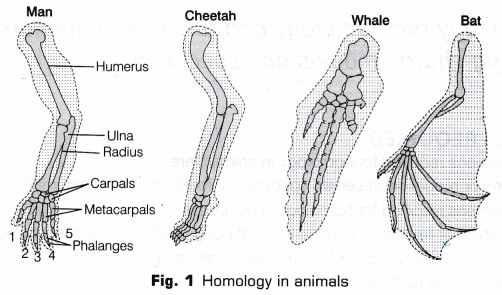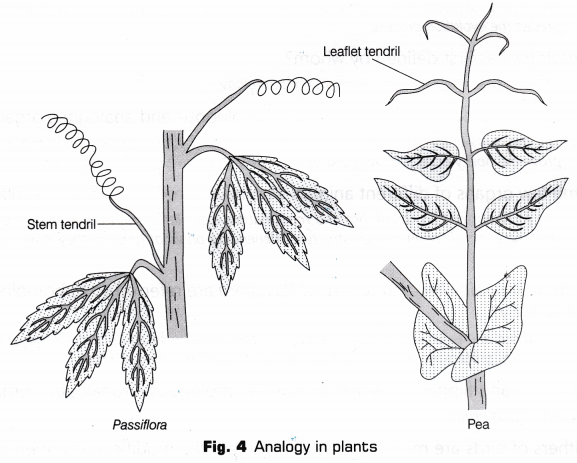CBSE Class 10 Science Lab Manual – Homology and Analogy of Plants and Animals
Aim
To study the homology and analogy in animals and plants using charts, models and specimens.
Materials Required
- Specimens required for homology in animals are:
Charts or model or preserved specimen of forelimb of bird, bat, man, seal, etc. - Specimens required for homology in plants are:
Preserved or fresh specimen of thorn of Bougainvillea and tendril of Cucurbita. - Specimens/charts required for analogy in animal are:
- Preserved forelimb of bat/bird.
- Preserved wings of insects.
- Specimens/charts required for analogy in plants are:
Preserved or fresh specimen of stem tendril in Passiflora and leaflet tendril in Pea.
Theory/Principle
The organs or features which have similar basic structure but performs different functions in different species are called as homologous organs and their study is called homology. These similarities are a result of divergence from a common ancestor, i.e. their origin from same species. Homologous organs are thus structurally similar but due to different habitats and their specific adaptations, they became functionally different, e.g. thorns of Bougainvillea and tendrils of Cucurbita are homologous organs.
The organs or features which have common or similar fundamental structures but are involved in different functions in different species are referred to as analogous organs and their study is called as analogy. These similarities arise due to the adaptive convergence of the different organs to be used in similar environment, e.g. wings of bat and wings of an insect are analogous organs.
Homology (similarities in traits of two different organisms) and analogy (similarities in functions of two different organisms) are common in occurrence in both plant and animal species. During the course of evolution, the organism adapts/recieves these organs or features from their ancestors.
Procedure
- The specimens of the limbs of both animals and plants are studied closely.
- Note the characteristic shape, structure, similarities, if any.
- Select the charts/figures of different animals and plants and study the details about homologous and analogous organs or features.
- Make a thorough observation of external and internal features and find out the similarity and dissimilarities (in structure and function) between them, then record your observations carefully in your notebook.
Observation
Homology/Homologous Organs
- The structures depict the forelimbs of a man, cheetah, whale and bat (see Fig. 1) in the case of animals.

- The hand of a man, limb of cheetah, flipper of a whale and the wings of a bat have common set of bones but all of these structures though appears similar but are involved in different functions like grasping, running, swimming and flying respectively.
- The structures depict Bougainvillea (thorn) and Cucurbita (tendrils) (see Fig. 2) in the case of plants.

- The leaves of the plant Bougainvillea have been modified into the thorns for protection while leaves in Cucurbita are made into tendrils for providing support in climbers.
- These structures of animals and plants under study show homology, i.e. similarity in the fundamental (basic) structures due to shared or common embryonic origin but all of these organs/features performs different functions.
Analogy/Analogous Organs
- The structures depict the wings of a bat and wings of an insect (see Fig. 3) in case of animals.

- The forelimbs of bats, birds and wings of insects are used for flying by these animals however, they are structurally very different from each other.
- The structures depict Passiflora (stem tendril) and pea (leaflet tendril) (see Fig. 4) in case of plants.

- The Passiflora and pea have leaves modified into tendrils which support the plant during climbing whereas they do not share any structural similarities.
- The above structures of animals and plants under study shows analogy, i.e. they perform similar functions in different organisms but do not share same structure on the basis of origin.
Result
The observations made on the above given structures reveals that during course of evolution, some organs of same origin in different organisms have taken up different functions, such organs are called as homologous organs, e.g. forelimbs of vertebrates and leaves in plants.
Some organs, in contrary, have evolved to perform the same function but their origin is not same and they do not resemble or are not similar to each other, such organs are called as analogous organs, e.g. wings of insects and birds.
Precautions
Handle the specimens carefully.
Observe the similarities and dissimilarities (structural and functional) in both animals and plants; and note down carefully.
Viva-Voce
Question 1.
Every organism has same basic structural plan. Explain your understanding about this.
Answer:
The basic structural plan of different related organism shows that few parts of the specified organ structure are same, so they have common ancestors.
Question 2.
From where does scientists gather the evidences for evolution process?
Answer:
The records of fossils, homologous and analogous organs, vestigial organs provide evidences to predict the evolution process.
Question 3.
Homology was first defined by whom?
Answer:
Richard Owen in 1843, first described the homology.
Question 4.
Is there a purpose behind the study of homologous and analogous organs?
Answer:
Yes, the study of these organs give us concrete evidence, supporting evolution process. They also prove the ability of all the living beings to be able to survive by adaptation and modification.
Question 5.
Name few organs of different animals who have same basic structural plan.
Answer:
The forelimbs of frog, lizard, bat and mammal have similar bones in their forelimbs. These show little modification in their structures depending on what function they have taken up to perform.
Question 6.
Thorn of Bougainvillea and tendril of Passiflora are referred to as homologous organs. Why?
Answer:
The thorn and tendril are modification of leaf, thus same in structure but different in functions, i.e. thorns protect the plant while tendril provides support during climbing.
Question 7.
Fins of fish and flippers of whale or seal is homologous or analogous organs?
Answer:
Analogous organ.
Question 8.
Feathers of birds are meant for flight, which are the modifications of epidermal hair. State their basic and primary function.
Answer:
Feathers are modifications of body hair. Their primary function is to keep the body of animal warm.
Question 9.
Give one example of analogous organs each for a plant and an animal.
Answer:
- Plant – Sweet potato (root modification) and potato (stem modification).
- Animal – Flippers of penguins and dolphins.
Question 10.
Analogous organs are different from homologous organs. How?
Answer:
| Analogous organs | Homologous organs |
| Structurally different but similar in function. | Structurally similar but differs in function. |
| Results from convergent evolution. | Results due to divergent evolution. |
| e.g. thorn in Bougainvillea and tendril in Passiflora. | e.g. limbs of man, whale, bats, etc. |
Question 11.
Define palaeontology and explain how is it related with study of evolution?
Answer:
Palaeontology is the study of fossils. Fossils are preserved specimens of organisms, their study reveals the varied life forms present over time.
Question 12.
Give one example of homology as observed in plants and animals.
Answer:
- Plants – Thorns of Bougainvillea and tendrils of Cucurbita
- Animals – Forelimbs of whales and bats.
Science Lab ManualScience Practical SkillsScience LabsMath LabsMath Labs with Activity
